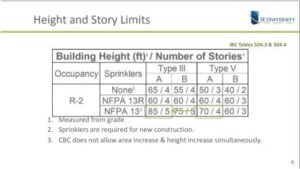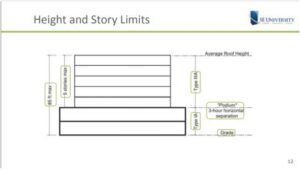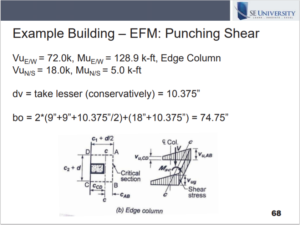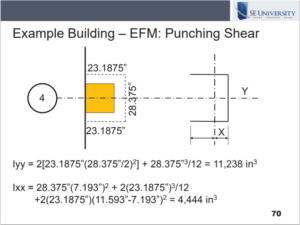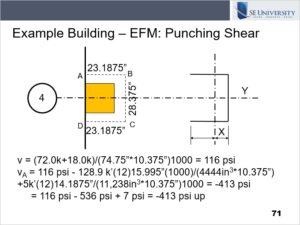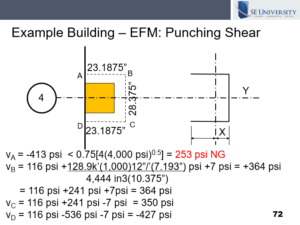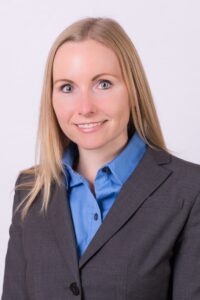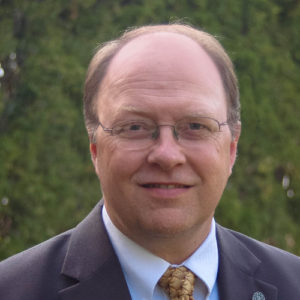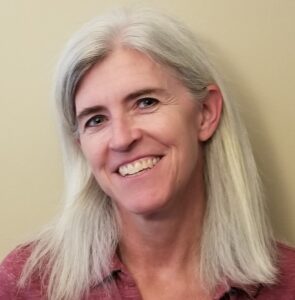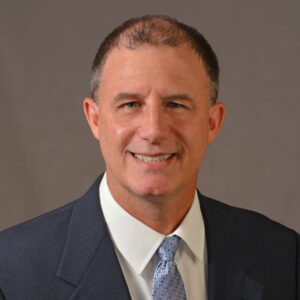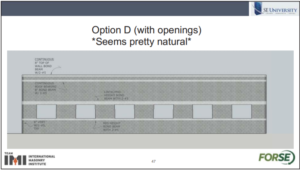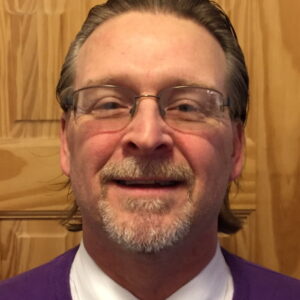While podium structures have gained in popularity in North America in recent years, engineers should be aware of the limitations set on building height for these wood over podium structures within the code.
In the April 2021 SE University session, Ashley Cagle, PE, SE, from WoodWorks, presented Structural Engineering of Light Frame Wood Over Concrete Podium Structures. Ashley reviewed code provisions from IBC and ASCE 7 that allow and limit podium-type structures. She also highlighted the implications of using fire retardant-treated wood in exterior wall assemblies of Type III construction and explained important issues that must be considered when designing mid-rise wood structures. Ashley showed effective detailing practices for wood shear wall tie-down attachments to concrete podium slabs during the session as well.
Ashley walked through the various code provisions which allow for maximizing the building height of a light frame wood over concrete podium structure. First, Ashley noted that Chapter 5 in the IBC specifies the maximum building height, number of stories and building area allowed based on occupancy, construction type, and the use of sprinklers. For new residential structures, sprinklers are required and the options are either NFPA 13R sprinklers, which are a residential sprinkler which restricts the height to 60 ft and 4 stories, or NFPA13 sprinklers which allow for an increase in building height by 20 ft., an increase of one additional story, and an increase in area of up to 3 times the square footage. (Note: For projects in California, the CBC does not allow the building height/additional story to be applied concurrently with the area increase, unless additional firewalls are provided.)
IBC Chapter 3 addresses occupancy, and Ashley noted these structures tend to have a lower concrete or steel portion that lends itself well to parking or commercial/retail space, while the upper wood portion tends to be mostly residential or hotel use. IBC Chapter 6 contains prescriptions for construction type, where type I/II is non-combustible, type III requires exterior walls to be non-combustible, type IV is heavy timber, and type V is any material allowed by code. Furthermore, subcategories A and B can be applied to types I,II, III, and V construction with A denoting an extra 1-hour fire rating on most primary and secondary structural elements over the requirements of type B. The building height limits are displayed in IBC Tables 504.3 and 504.4 or as shown below from Ashley’s example in her presentation. For type III construction, fire-retardant treated wood can be used as a non-combustible material to satisfy this provision.
At the end of IBC Chapter 5, Section 510.2 lists a number of provisions for mixed occupancy and this section allows that “A building shall be considered as separate and distinct buildings” if there is a 3-hour fire-rated horizontal separation, it is construction Type IA below the separation and group A occupancy above the separation, and a 2-hour fire rating exists for any vertical shaft penetrating through the horizontal separation. Thus, Ashley provided the following graphic showing the building height possibilities with a light-frame wood over concrete podium structure.
As you can see, using an upper building type IIIA construction, over a Type IA lower structure, one can achieve a 5 story upper structure with 85 feet of total building height measured from grade when a 3-hour fire-rated horizontal separation is provided between the two separate and distinct structures. These two structures can then be analyzed according to the two-stage lateral analysis detailed in ASCE 7 Section 12.
Wood over podium structures have gained in popularity in recent years, and Ashley offered additional resources for engineers who find themselves with questions on these mixed-use or mid-rise wood buildings which can be found free of charge at WoodWorks.org. One resource that Ashley specifically mentioned is a published design example for a Five-Story Wood-Frame Structure over Podium Slab. When designing these structures, it is important to have an understanding of the building height requirements, and know how construction types and occupancy can impact the allowable building height.
29 Dec 2021
Punching Shear Review for Concrete Flat Plates
Punching shear checks are vital when using concrete flat plates due to the brittle nature of this failure mode. Punching shear failure can be avoided by increasing the slab depth or incorporating other shear enhancement techniques, but are these enhancements necessary or does the flat plate have enough capacity on its own?
In the September 2021 SEU session, Michael E. Sheridan, PE, SE, from Allen & Hoshall, Inc., presented Concrete Flat Plate Design. Michael explained the basic concepts of nonprestressed, flat plate load distribution using the Equivalent Frame Method (EFM) as defined in ACI 318-14. He also covered design processes including loads, live load reduction, slab thickness and punching shear for concrete flat plates.
Michael walked through an example for determining the punching shear capacity of a flat slab at an edge column interface. The shear and moments applied to this column have already been determined by using the Equivalent Frame Method. Since this is an edge column, the critical punching shear stress will be a combination of the direct shear stress from each of the contributing column strips as well as the shear resulting from the applied moments in each direction. The result of these combined forces will be determined at each corner of the critical section.
For the 18 inch square column, the critical section, bo equals 74.75 inches and the depth, dv is taken conservatively as 10.375 inches for the 12.5 inch slab. Michael determines the distance to the centroid, X to be 7.193 inches and can then calculate the moments of inertia in both directions.
Using the applied shear force, the critical section and depth of the slab, the direct shear stress, v, is calculated to be 116 psi. For each corner of the critical section, the contributing shear due to the applied moments in each direction are calculated using Mc/I.
The total applied shear stress exceeds the allowable shear capacity as determined by Chapter 22 of ACI 318, thus the slab fails the punching shear check for this edge column for the applied loads. Either the total slab depth would need to be increased, or the engineer could explore the use of stud rails, shear heads or drop panels to avoid a sudden punching shear failure in this building.
In December 2021, SEU welcomed Don Scott, PE, SE, from PCS Structural Solutions, and Cherylyn Henry, PE, from Zapata, to present ASCE 7-16 Wind (plus Updates). Don and Cherylyn designated the SEI Futures Fund (https://www.asce.org/communities/institutes-and-technical-groups/structural-engineering-institute/futures-fund) for our SEU Speaker Inspires donation for the month.
Cherylyn shared “The SEI Futures Fund has provided an invaluable opportunity for students and young professionals to engage in the structural engineering profession. The Fund’s dedication to advancing our profession through the next generation of engineers has benefited practitioners and academics alike, through scholarships to attend Structures Congress and funding to serve on Codes and Standards Committees. I have witnessed the increased involvement of young professionals in our profession and it’s been incredibly exciting!”
Thank you, Don and Cherylyn, for helping structural engineers with your SEU session, and for your designation of the SEI Futures Fund as our SEU Speaker Inspires Organization of the Month!
SEU began the SEU Speaker Inspires program in 2015 as a way to “pay it forward”, enabling our speakers to designate a charity/organization of their choice for SEU to make a donation to help improve our world.
In November 2021, SEU welcomed Tim Holtermann, PE, SE, from Canam Steel, and Bruce Brothersen, PE, SE, from Vulcraft, on behalf of the Steel Joist Institute, to present Bridging and Steel Joists. Bruce designated Utah State University Civil Engineering Department Steel Bridge Team (https://engineering.usu.edu/cee/) for our SEU Speaker Inspires donation for the month.
Bruce shared “There is a lot more to the education of engineers than learning equations and running numbers. Anytime student engineers can be involved with projects that require innovation, collaboration and teamwork, like the bridge team as USU, a donation is a great investment in the engineering learning process.”
Thank you, Bruce, for helping structural engineers with your SEU session, and for your designation of the Utah State University Civil Engineering Department Steel Bridge Team as our SEU Speaker Inspires Organization of the Month!
SEU began the SEU Speaker Inspires program in 2015 as a way to “pay it forward”, enabling our speakers to designate a charity/organization of their choice for SEU to make a donation to help improve our world.
In October 2021, SEU welcomed Susan Burmeister, PE, from S2B Structural Consultants, to present Camber – Design and Construction. Susan designated Engineers without Borders (https://www.ewb-usa.org/) for our SEU Speaker Inspires donation for the month.
Engineers Without Borders USA builds a better world through engineering projects that empower communities to meet their basic human needs. Their highly skilled volunteers work with communities to find appropriate solutions for their infrastructure needs.
Thank you, Susan, for helping structural engineers with your SEU session, and for your designation of the Engineers without Borders as our SEU Speaker Inspires Organization of the Month!
SEU began the SEU Speaker Inspires program in 2015 as a way to “pay it forward”, enabling our speakers to designate a charity/organization of their choice for SEU to make a donation to help improve our world.
In September 2021, SE University welcomed Michael E. Sheridan, PE, SE, SECB, from Allen & Hoshall, to present Concrete Flat Plate Design. Mike designated Grace to You (https://www.gty.org/) for our SEU Speaker Inspires donation for the month.
Mike shared “My life has changed so dramatically in the last 30 years, when Jesus Christ intervened into my life with the truth of the gospel. This one major turning point in my life came through the truth found in Holy Scripture. John MacAruthur is the Chancellor of the Master’s College and Bible Teacher of the Grace to You ministry. I listen to Grace To You on the radio and podcasts daily and it is a significant augmentation to my ongoing Bible studies. So, whenever I get a chance to come into some extra money, I support their work at Grace to You. I hope this donation will help their work to continue in the sharing of Jesus Christ and the truth found in Him.”
Thank you, Mike, for helping structural engineers with your SE University session, and for your designation of Grace to You as our SEU Speaker Inspires Organization of the Month!
SE University began the SEU Speaker Inspires program in 2015 as a way to “pay it forward”, enabling our speakers to designate a charity/organization of their choice for SE University to make a donation to help improve our world.
Structural strengthening with externally bonded FRP has grown in popularity in recent years and provides a viable option for strengthening reinforced concrete for seismic applications, remediations or retrofit of existing structures. Many products are available on the market, and design guidance has been included in building codes for a number of years. Are you aware of the benefits and limitations of this type of external reinforcement?
In the July 2021 SE University session, Mark Jarvinen, PE, from Simpson Strong-Tie, presented Design Methodology and Calculations using Fiber-Reinforced Polymer Systems. Mark covered the design philosophy presented in ACI 440.2R-17 and ACI 318 and explained the strengthening limitations of FRP. Mark walked through the design methodology for FRP strengthening of a reinforced concrete beam for shear and flexure, as well as improving reinforced concrete column strength with FRP confinement.
Mark reviewed important considerations when using FRP for shear strengthening of reinforced concrete beams. FRP has been shown to increase the shear strength of existing reinforced concrete beams by wrapping or partially wrapping the beam. The FRP fiber is oriented transverse to the longitudinal axis or perpendicular to shear cracks in the member. Mark noted that shear cracks must be epoxy injected before the addition of FRP in order to reestablish any aggregate interlock that has been lost due to the cracks. This is imperative in order to consider the contribution of the concrete when determining the combined shear strength of the member. However, depending on the quality of the workmanship for the crack repair, the engineer may want to consider the implication on the shear strength provided by the concrete during design. Mark noted these cracks should be repaired using a product that meets ASTM C881, Type IV criteria for such a load bearing application.
Three types of FRP wrapping schemes can be used for shear strengthening of RC beams: completely wrapped, 3-sided or U-wrapped, or 2-sided wraps. These can be continuous or discrete strips. Mark advised that discreet strips allow for moisture migration which can be essential when working with beams exposed to the elements. FRP as well as the primer used before its application are vapor barriers and will contain moisture within the element if used continuously.
Follow along, as Mark walks through a design example using discrete FRP U-wraps to increase the shear strength of a reinforced concrete beam according to the guidelines in ACI 440.2R-17 and ACI 318 by watching this short 4 minute video:
After Mark determines that the reinforced shear strength is greater than the shear demand on the member, he checks the shear strengthening limit to ensure the total shear strength provided by the steel plus the FRP is not greater than the criteria provided in ACI 318 for steel alone according to ACI 440.2R-17, Sec. 11.4.3. Lastly, he determines how far into the span the discrete strips are needed by plotting the shear diagram of the member to determine where the strips are no longer necessary. For further guidance, click here to access the full design example shared by Mark to learn more about the design calculations and limit checks needed to use FRP for shear strengthening of reinforced concrete beams.
Are you stuck in an empirical rut when it comes to locating control joints in your structural masonry walls? Control joints at 25 feet on center with standard joint reinforcement is typical for many engineering projects, however, some buildings warrant a closer look at minimizing the use of control joints in order to achieve a more efficient wall and a cost effective solution.
In August 2021, Sam Rubenzer, PE, SE, from FORSE Consulting, presented Movement Joints for Masonry – Structural Edition for SE University. Sam explored the role of masonry movement joints in structural masonry walls, as well as the movement properties of masonry materials and structural systems. He explained the purpose of joints, what to consider when locating them, and who is responsible for locating them according to the code.
During the presentation, Sam gave an example with 5 options for horizontal reinforcement for the same basic wall design using the NCMA TEK guides 10-2D and 10-3. Using both the empirical approach and an engineered approach, the following 5 options were presented as viable options: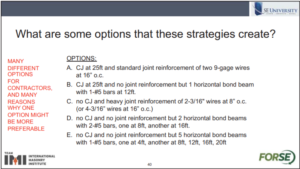
- Option A is a very commonly used empirical method for determining CJ spacing with typical joint reinforcement which most contractors would be very familiar with.
- Option B offers a similar CJ spacing while eliminating joint reinforcement in lieu of a single reinforced bond beam.
- Option C eliminates all control joints, but includes heavy joint reinforcement closely spaced.
- Option D also has no CJs but includes 2 reinforced bond beams.
- Option E eliminates all CJs but includes 5 reinforced bond beams at various heights.
All of these options satisfy the need for horizontal reinforcement to control cracking for this basic structural masonry wall, however one option may be preferable over another depending on the contractor doing the work or the need for additional structural capacity of a longer shear wall with less control joints.
These additional options become even more beneficial when considering more complicated walls with openings. Walls with repeated large openings spaced closely together become less efficient with control joints located between each opening. Thus, a continuous reinforced bond beam makes more sense to eliminate the use of control joints between each opening. As you can see from these two slides, the second option makes good sense, and offers a wall with less overall maintenance costs and would most likely cost less to construct.
Control joints are certainly necessary in certain situations where stress concentrations are likely to accumulate such as corners, intersecting walls, or a wall with a change in height. However, in many cases, minimizing the number of control joints can produce a more cost efficient wall design that is easier to construct and maintain over the life of the structure.
In August 2021, SE University welcomed Sam Rubenzer, PE, SE, from FORSE Consulting, to present Movement Joints for Masonry: Structural Edition. Sam designated Fellowship of Christian Athletes (https://www.fca.org/) for our SEU Speaker Inspires donation for the month.
Sam shared “Fellowship of Christian Athletes is a good organization to provide support for students mind body and spirit. The organization especially encourages athletes to stay grounded in the teachings of Jesus, and put their faith in action while pursuing their goals in sports.”
Thank you, Sam, for helping structural engineers with your SE University session, and for your designation of Fellowship of Christian Athletes as our SEU Speaker Inspires Organization of the Month!
SE University began the SEU Speaker Inspires program in 2015 as a way to “pay it forward”, enabling our speakers to designate a charity/organization of their choice for SE University to make a donation to help improve our world.
In July 2021, SE University welcomed Mark Jarvinen, PE, from Simpson Strong-Tie, to present Design Methodology and Calculations using Fiber-Reinforced Polymer Systems. Mark designated Forgotten Felines and Fidos (http://www.forgottenfelines.org/) for our SEU Speaker Inspires donation for the month.
Mark shared “Animals have no voice to advocate for their welfare or express their suffering and neglect. There are so many domesticated animals that need help that charitable organizations can’t reach them all. I respect and want to help those in our society that care for neglected and abused animals that so desperately need assistance. I chose Forgotten Felines and Fidos because of their unselfish commitment to caring for displaced cats and dogs in northwestern Lehigh County.”
Thank you, Mark, for helping structural engineers with your SE University session, and for your designation of Forgotten Felines and Fidos as our SEU Speaker Inspires Organization of the Month!
SE University began the SEU Speaker Inspires program in 2015 as a way to “pay it forward”, enabling our speakers to designate a charity/organization of their choice for SE University to make a donation to help improve our world.

